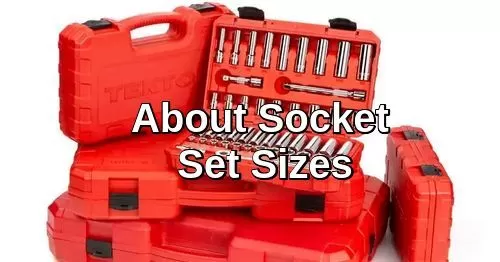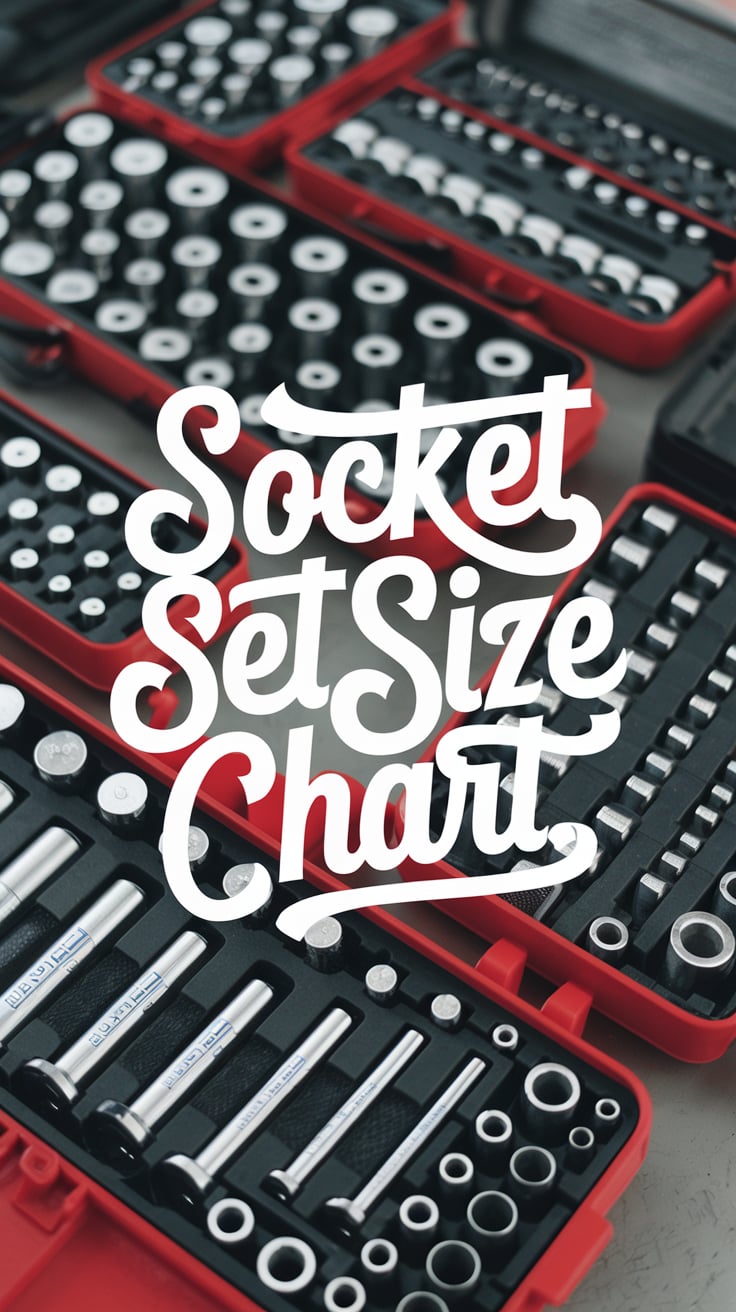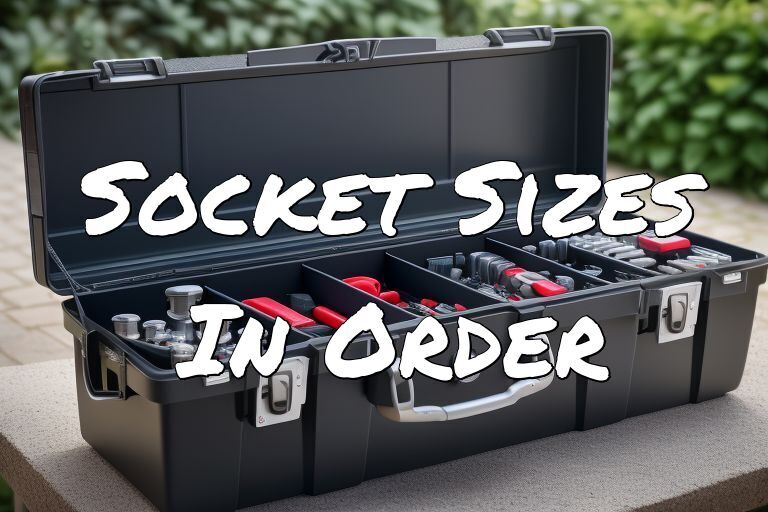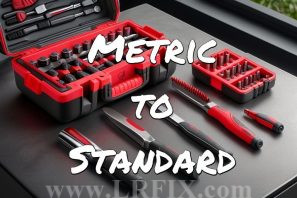Socket Sizes In Order
With many different socket sizes, types and sets to choose from, it can be challenging to organize a collection of sockets tailored to your needs.
This page will help you discover the precise order of Metric and Standard socket sizes, for each set and type, and ensure your sockets are organized and ready to work.
Learn more about the different socket sets, their benefits, and their uses, too.

Metric Socket Size Chart
| 1/4” Set | 3/8” Set | 1/2” Set | 3/4” Set | 1” Set |
|---|---|---|---|---|
| 4 mm | 10 mm | 10 mm | 19 mm | 76 mm |
| 5 mm | 11 mm | 11 mm | 21 mm | 77 mm |
| 6 mm | 12 mm | 12 mm | 22 mm | 78 mm |
| 7 mm | 13 mm | 13 mm | 23 mm | 80 mm |
| 8 mm | 14 mm | 14 mm | 24 mm | 85 mm |
| 9 mm | 15 mm | 15 mm | 26 mm | 90 mm |
| 10 mm | 16 mm | 16 mm | 27 mm | 95 mm |
| 11 mm | 17 mm | 17 mm | 29 mm | 100 mm |
| 12 mm | 18 mm | 18 mm | 30 mm | 105 mm |
| 13 mm | 19 mm | 19 mm | 32 mm | 110 mm |
| 14 mm | 20 mm | 35 mm | 115 mm | |
| 21 mm | 36 mm | |||
| 22 mm | ||||
| 23 mm | ||||
| 24 mm |
* Number of sockets per set may vary by brand.
Standard Socket Size Chart
| 1/4” Set | 3/8” Set | 1/2” Set | 3/4” Set | 1” Set |
|---|---|---|---|---|
| 3/16" | 1/4" | 3/8" | 7/8" | 7/8" |
| 7/32" | 5/16" | 7/16" | 15/16" | 1" |
| 1/4" | 3/8" | 1/2" | 1" | 1-1/8" |
| 5/16" | 7/16" | 9/16" | 1-1/16" | 1-1/4" |
| 11/32" | 1/2" | 5/8" | 1-1/8" | 1-3/8" |
| 3/8" | 9/16" | 11/16" | 1-3/16" | 1-1/2" |
| 11/32" | 5/8" | 3/4" | 1 1/4" | 1-5/8" |
| 3/8" | 11/16" | 13/16" | 1-5/16" | 1-3/4" |
| 7/16" | 3/4" | 7/8" | 1-3/8" | 1-7/8" |
| 1/2" | 13/16" | 15/16" | 1-7/16" | 2" |
| 9/16" | 7/8" | 1" | 1-1/2" | |
| 1-1/16" | 1-5/8" | |||
| 1-3/4" | ||||
| 1-13/16" | ||||
| 1-7/8” | ||||
| 2" |
* Sets may include additional sockets.
Tip: Use a socket set conversion chart to see which metric and standard sockets are equal.

6 vs 12 point Sockets
A 6 point socket has a hexagonal contact area that fits snugly over common hexagonal bolts. A 12 point socket has a contact area that resembles a star and can fit hexagonal bolts as well as less common square bolts.
After 3 decades of wrenching on small engines I find that 6 point sockets perform better than 12 point sockets. Fitting firmly over a bolt is better than being able to hold any bolt less firmly.
Functionally, a 6 point socket is capable of delivering more torque (force) than a 12 point socket while also being less likely to damage the bolt. The tradeoff, a 12 point socket is more versatile because it is compatible with a wider range of bolt types.
1/4" Set Sizes
1/4" socket sets are designed for occasional, light duty use around the home. They are ideal for small tasks such as tightening hose clamps and removing bolts from small appliance panels.
Metric 1/4" drive socket set sizes in order: 4, 5, 6, 7, 8, 9, 10, 11, 12, 13, & 14mm. (11 sockets)
Standard(SAE) 1/4" drive socket set sizes in order: 3/16”, 7/32”, 1/4”, 9/32”, 5/16”, 11/32”, 3/8”, 7/16”, 1/2” & 9/16”
3/8" Set Sizes
3/8" socket sets are designed for all-purpose general duty use. They are capable of handling the nuts and bolts most commonly found on home outdoor power equipment.
Metric 3/8" drive socket set sizes in order: 10, 11, 12, 13, 14, 15, 16, 17, 18 & 19mm. (10 sockets)
Standard(SAE) 3/8" drive socket set sizes in order: 5/16", 3/8", 7/16", 1/2", 9/16", 5/8", 11/16" & 3/4". (8 sockets)
1/2" Set Sizes
1/2" drive socket sets are a more durable version of 3/8" sets. They don't include a few of the most common smaller-sized sockets but do include larger ones perfect for vehicles and machinery.
Metric 1/2" drive socket set sizes in order: 10, 11, 12, 13, 14, 15, 16, 17, 18, 19, 20, 21, 22, 23 & 24mm. (15 sockets)
Standard(SAE) 1/2" drive socket set sizes in order: 3/8", 7/16", 1/2", 9/16", 5/8", 11/16", 3/4", 13/16", 7/8", 15/16", 1", 1-1/16", 1-1/8" & 1-1/4". (14 sockets)
3/4" Set Sizes
3/4" socket sets are an ideal continuation to 3/8" socket sets. This is because the smallest sockets in a 3/4 set are most often slightly larger than the largest sockets in a 3/8 set, as you can see in the chart above.
Additionally, 3/4" ratchets and spanners are capable of delivering enough torque to free all but the most stubborn bolts and can tighten bolts to a higher torque spec than smaller ratchets.
Metric 3/4" drive socket set sizes in order: 19, 21, 22, 23, 24, 26, 27, 29, 30, 32, 35, 36, 38, 41, 46 &, 50mm. (16 sockets)
Standard(SAE) 3/4" drive socket set sizes in order: 7/8, 15/16, 1, 1/16, 1 1/8, 1 3/16, 1 1/4, 1 5/16, 1 3/8, 1 7/16, 1 1/2, 1 5/8, 1 3/4, 1 13/16, 1 7/8, and 2”. (16 sockets)
1" Set Sizes
Most 1" socket sets available online and at hardware stores are designed to be used with electric or air powered impact drivers. They don't often have a ratchet, also known as a spanner, included in the set.
Impact drivers deliver torque to the socket in short bursts, which helps loosen extremely tight or stuck bolts without breaking them.
Impact sockets are commonly made of chrome Vanadium (Cr-V) or other strong metals resistant to breaking under extreme amounts of torque.
Metric 1" drive socket set sizes in order: 76, 77, 78, 80, 85, 90, 95, 100, 105, 110 & 115mm. (11 sockets)
Standard(SAE) 1" drive socket set sizes in order: 1, 1-1/8, 1-1/4, 1-3/8, 1-1/2, 1-5/8, 1-3/4, 1-7/8 & 2". (9 sockets)
Beginner Sets
A 3/8" socket set is an ideal choice for the average person who will use it only occasionally around the home. It typically strikes the best balance between cost and utility, and it contains sockets for most common bolt sizes, including 1/4" and 10 mm.
Deep vs Shallow Sets
Deep sockets, also referred to as long sockets, are required for tightening or removing the nut from a long bolt. They are longer and able to fit over the shaft of the bolt.
Shallow sockets, often called normal or short sockets, may not reach a fastener if a bolt shaft is protruding from it. They are designed for tightening and removing easily accessible fasteners.
Shallow sockets are good to access bolts in difficult to reach places where deep sockets may not have enough clearance.
Combination Sets
A combination socket set typically costs more than buying individual sets, but less than buying both sets seperately. Most combination sets come with a handy molded storage case to keep sets well organized.
Metric + Standard Sets
This is the most common combination of socket sets, it includes Metric and Standard versions of each socket. This is the ideal combination set to choose if you want to be prepared with the right socket for either measurement system.
Deep + Shallow Sets
A deep and shallow combination set is a good choice when you are confident you will only need to service fasteners of one measurement system (Metric OR Standard, not both). This type of set ensures you will have the right socket for short and long fasteners.
Multi-Size Socket Sets
A multi-size combination socket set contains sockets of more than one drive size. This is a popular choice for the person wanting a wide range of socket sizes all neatly stored in one case.



